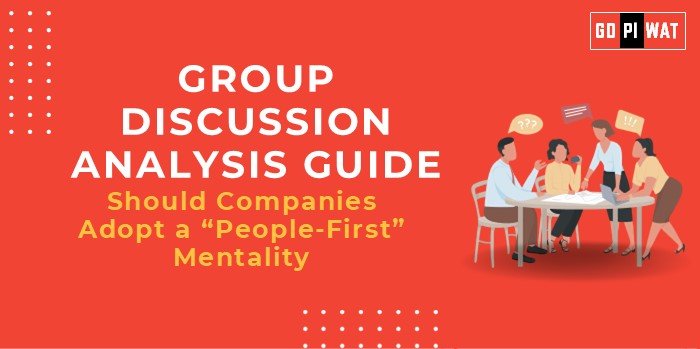📋 Group Discussion Analysis Guide
🌟 Topic: Should Companies Adopt a “People-First” Mentality?
🌐 Introduction to “People-First” Mentality
Opening Context: “As organizations navigate an increasingly competitive and dynamic global market, the debate around prioritizing employees—‘people-first’ mentality—has intensified. Companies such as Google and Salesforce demonstrate that employee well-being can drive productivity, but concerns over profitability and operational priorities remain.”
Topic Background: The “people-first” philosophy emphasizes putting employees’ needs, growth, and well-being at the center of organizational decisions. Originating from human resource-centric movements, it has evolved in the 21st century alongside shifting workforce dynamics, employee engagement trends, and increasing focus on mental health.
📊 Quick Facts and Key Statistics
- 📈 Employee Engagement: Companies with high employee engagement report 21% higher profitability (Gallup, 2023).
- 💰 Turnover Costs: Replacing an employee costs businesses 33% of their annual salary (SHRM).
- ⚠️ Workplace Burnout: 77% of employees have experienced burnout at least once (Deloitte, 2023).
- 🚀 Productivity Impact: Happy employees are 13% more productive (Oxford University Study).
- 🌐 Remote Work Benefits: Companies embracing flexible models see a 12% improvement in retention rates (McKinsey, 2023).
👥 Stakeholders and Their Roles
- Companies: Implement employee-friendly policies while balancing operational efficiency.
- Employees: The direct beneficiaries of people-first practices; contribute to company success through higher motivation and productivity.
- Investors: Concerned with profitability and ROI, often cautious about resource-intensive employee initiatives.
- Governments: Promote labor laws and policies, ensuring worker rights and mental health support.
- Unions/Advocacy Groups: Push for fair wages, workplace conditions, and policies.
🏆 Achievements and Challenges
🎉 Achievements of a People-First Approach:
- 💼 Higher Retention Rates: Companies like Netflix and Salesforce retain employees through flexible policies and growth opportunities.
- 📈 Improved Productivity: Google’s focus on mental health support programs boosts employee efficiency.
- 🌟 Employer Branding: Microsoft’s focus on employee well-being strengthens its appeal as an employer of choice.
- 💹 Profitability Growth: A study by the Great Place to Work Institute showed companies prioritizing culture had a 4x increase in revenue growth.
⚠️ Challenges of Adopting a People-First Mentality:
- 💸 Cost Concerns: Significant investments in employee programs strain smaller firms’ budgets.
- 🕒 Short-term vs. Long-term Gains: ROI may not immediately reflect on balance sheets.
- 🚧 Cultural Resistance: Traditional industries may resist prioritizing “people” over rigid efficiency metrics.
🌍 Global Comparisons:
- 🇩🇰 Denmark: Known for its “flexicurity” model combining employee well-being with business growth.
- 🇯🇵 Japan: Historically prioritizes company loyalty but struggles with work-life balance.
📖 Case Studies:
- Salesforce: Introduced family care leave and mental health programs, reporting a 96% employee satisfaction rate.
- Patagonia: Offers childcare facilities and flexible hours, leading to low turnover rates.
💡 Structured Arguments for Discussion
- ✅ Supporting Stance: “Adopting a people-first mentality fosters employee loyalty, increases productivity, and enhances profitability in the long term.”
- ❌ Opposing Stance: “While people-first approaches are idealistic, companies must focus on profitability and operational efficiency to survive, especially in competitive markets.”
- ⚖️ Balanced Perspective: “While prioritizing employees drives long-term growth, companies must strike a balance by aligning people-first policies with financial sustainability.”
✔️ Effective Discussion Approaches
- Opening Approaches:
- 📊 Statistic Approach: “Companies with high employee engagement outperform those without by 21%, proving that happy employees drive results.”
- 📋 Case Study: “Salesforce’s people-first initiatives have not only increased retention but also contributed to its brand as an employer of choice.”
- Counter-Argument Handling:
- 💡 Response to Cost Concerns: “While initial costs are high, research shows long-term gains in retention and profitability outweigh these expenses.”
- 💡 Response to Productivity Criticism: “Flexible work policies don’t harm productivity; they improve it, as seen in a 13% rise among remote workers.”
📈 Strategic Analysis of Strengths and Weaknesses
- Strengths: Improved employee engagement, better employer branding, higher productivity.
- Weaknesses: Initial cost burdens, risk of inefficiency, cultural resistance.
- Opportunities: Increased adoption of hybrid work models, mental health programs.
- Threats: Economic downturns, investor skepticism.
📚 Connecting with B-School Applications
- Real-World Applications:
- HR Projects: Designing employee well-being programs with measurable ROI.
- Operations Management: Balancing employee satisfaction with productivity.
- Finance: Analyzing long-term cost benefits of people-first policies.
- Sample Interview Questions:
- 💬 “What is the ROI of adopting a people-first culture in companies?”
- 💬 “Can people-first policies work in labor-intensive or cost-sensitive industries?”
- Insights for B-School Students:
- Strategic Alignment: People-first approaches must align with a company’s financial goals.
- Practical Implementation: Focus on case studies like Salesforce and Patagonia to understand execution.
- Leadership Impact: Employee satisfaction begins with leadership that prioritizes well-being.


